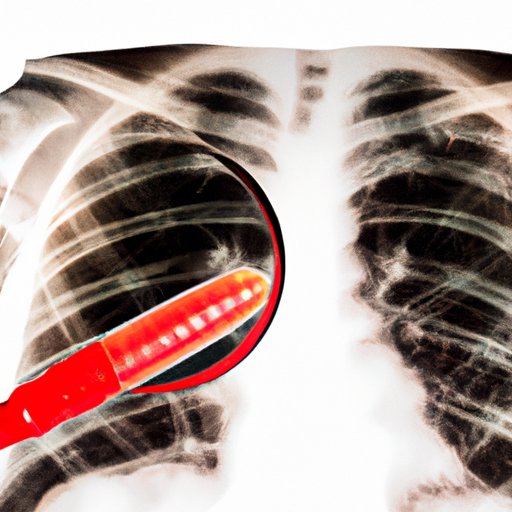Introduction
Tuberculosis, also known as TB, is a serious bacterial infection that affects millions of people worldwide. According to the World Health Organization (WHO), TB is one of the top ten causes of death worldwide, and in 2019 alone, it caused 1.4 million deaths globally. The purpose of this article is to provide readers with a comprehensive understanding of TB, including its causes, symptoms, diagnosis, treatment, prevention, and impact on global health.

The Silent Killer: Understanding the Basics of Tuberculosis
TB is a bacterial infection caused by the bacterium Mycobacterium tuberculosis. It primarily affects the lungs but can also affect other parts of the body such as the kidneys, spine, and brain. TB spreads through the air when an infected person coughs or sneezes, and another person inhales the bacteria.
Anyone can get TB, but people who have weakened immune systems, such as those with HIV, malnutrition, or diabetes, are more susceptible. People who live in crowded or unhygienic conditions, such as prisons and refugee camps, are also at a higher risk of contracting TB.
The symptoms of TB include a persistent cough that lasts for more than three weeks, coughing up blood, chest pain, fatigue, weight loss, decreased appetite, and fever.
TB: More Than Just a Cough
There are two types of TB: latent TB and active TB. Latent TB means that a person has been infected with TB bacteria but does not have any symptoms and is not contagious. Active TB means that a person is actively experiencing symptoms and is contagious.
Pulmonary TB is the most common form of TB, which primarily affects the lungs. It can cause symptoms such as coughing up blood, chest pain, and shortness of breath. Extrapulmonary TB affects other parts of the body such as the lymph nodes, kidneys, and spine. The symptoms of extrapulmonary TB depend on the affected organs.
Diagnosing and Treating TB: The Facts You Need to Know
The diagnosis of TB involves a series of tests such as a physical exam, a skin test, a chest X-ray, and a sputum culture test to detect the presence of TB bacteria. Upon a positive diagnosis, TB can be treated with a combination of antibiotics for six to nine months. While TB medication is effective, it can have side effects such as nausea, vomiting, and liver problems. It is important to complete the entire course of treatment to prevent drug-resistant TB from developing.
The Global Impact of Tuberculosis: How You Can Make A Difference
According to WHO, TB is most prevalent in low-income areas and can be a significant barrier to economic growth. In 2019, TB affected an estimated ten million people worldwide, with the highest incidence rates observed in Africa, Asia, and Eastern Europe.
Governments and organizations play a crucial role in reducing TB burden through funding research, developing new treatments, and implementing prevention programs. Individuals can contribute to TB control efforts by educating themselves and others about the disease, supporting organizations that work to eradicate TB, and advocating for increased funding for TB research.
A Comprehensive Guide to Preventing Tuberculosis
The most effective way to prevent TB is through vaccination with the Bacillus Calmette-Guérin (BCG) vaccine, which is widely used in many countries. Good hygiene practices such as washing hands, covering the mouth when coughing or sneezing, and proper ventilation can also reduce the risk of TB exposure.
Reducing the risk of TB exposure is particularly vital for people living or working in high-risk areas, such as healthcare workers and those who work in crowded or unsanitary conditions. Routine screening and treatment for TB can also prevent future transmission of the disease.
Myths and Misconceptions Surrounding Tuberculosis
There are many myths and misconceptions surrounding TB, which can lead to stigma and discrimination against people living with TB. Common myths include the idea that TB only affects poor and unhygienic people or that TB can be transmitted through sharing utensils or clothing. The truth is that anyone can get TB, and it can only be transmitted through the air when an infected person coughs or sneezes.
It is essential to spread accurate information about TB to reduce stigma and encourage people to seek medical assistance if they or someone they know may have TB.
The History of Tuberculosis: From Ancient Times to the Present Day
TB has affected humans for thousands of years. Evidence of TB has been found in the remains of Ancient Egyptians and Greeks. In the 19th and early 20th centuries, TB was a leading cause of death in Europe and America, earning it the nickname “consumption.”
As scientific understanding of the disease increased, successful treatments were developed, and TB rates began to decline. Today, TB remains a significant global health concern but has seen a slow decrease in incidence rates in high-burden countries.
Conclusion
TB is a serious and sometimes deadly disease that impacts millions of people worldwide. Through vaccination, good hygiene practices, routine screening, and adequate treatment, we can take steps to prevent the spread of TB and reduce the global burden of the disease. It is essential to spread accurate information about TB to reduce stigma and encourage people to seek medical assistance if they suspect they have TB. Together, we can work to stop the spread of this silent killer.
